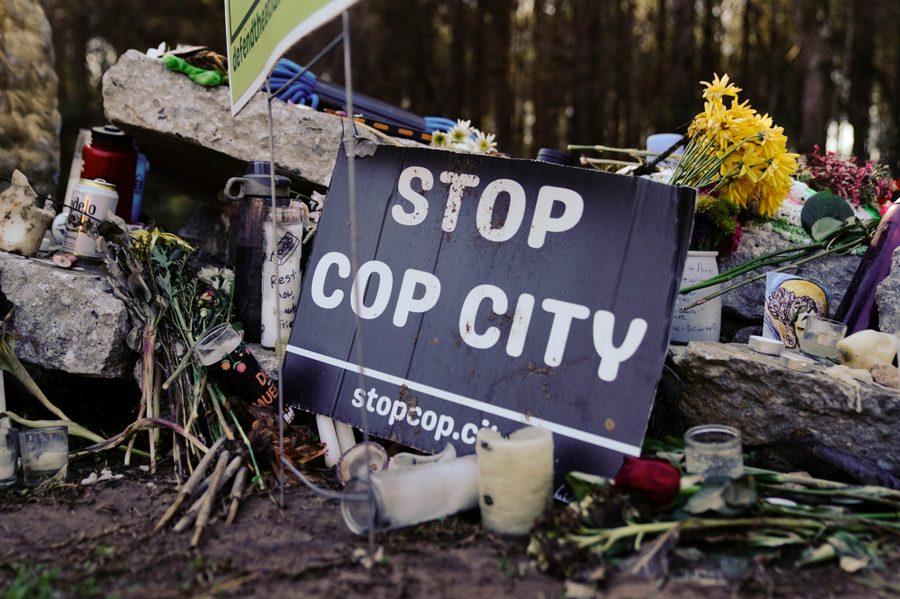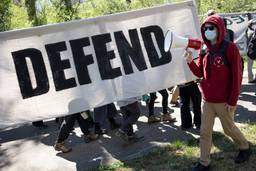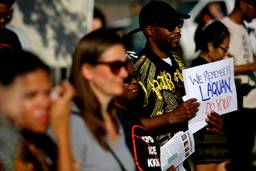No Cop City Anywhere
Chicago’s #NoCopAcademy campaign and #StopCopCity in Atlanta are part of the same movement: to end violent policing, protect the environment and defend Black and brown lives.
Benji Hart

A monumental struggle is currently taking place in the Weelaunee Forest in DeKalb County near Atlanta, Georgia.
The local government plans to level 85 acres of the forest to build a $90 million police training facility. The natural environment that would be lost is not only a precious recreational resource for Atlanta residents, but a crucial bulwark protecting against flooding and other climate change-related disasters, which are on the rise. Despite city leaders’ commitment to ramming the project through undemocratically, a decentralized campaign known as #StopCopCity is fighting back.
The movement is connecting police and prison abolition with environmental justice, and uniting organizations and individuals from across the political spectrum in demanding the city divert resources away from militarization and towards fighting climate change and protecting Black and brown lives.
The threat of a militarized megadevelopment, and the intersectional, multiracial coalition mobilizing to resist it, bear some striking parallels with the recently-opened police academy in Garfield Park, Chicago — and the youth-led #NoCopAcademy campaign that fought its construction nearly six years ago.
After closing half of Chicago’s free mental health clinics as well as 49 public schools in almost exclusively Black neighborhoods between 2012 and 2013, then-Mayor Rahm Emanuel announced in July 2017 that the Chicago Police Department (CPD) — which already received 40% of the city’s annual budget — would receive a new $95 million investment in the form of a state-of-the-art training facility.
Like Cop City in Atlanta, the sprawling campus would include a mock city block in which to practice raids and other militarized maneuvers, in addition to a swimming pool, food court and shooting range. In the wake of the 2014 CPD murder of 17-year-old Laquan McDonald, the U.S. Department of Justice issued a report recommending an upgrade in “CPD’s physical training facilities.” In response, the city claimed the new academy would help improve community relations with police following the Black Lives Matter uprisings that took place after video of McDonald’s killing was released to the public.
That’s not the only similarity. Cop City is slated to be built on the same site as former prison farms where Atlanta once consigned incarcerated people to labor. The police academy in Chicago is located in a predominantly poor, Black community with a long history of disinvestment and carceral violence. Both compounds were forced onto residents by Democratic mayors — including women mayors of color — despite being unpopular and vocally opposed by the public.
The construction of both compounds has been materially supported by some of the most craven organizations not just in the carceral sector, but in the destruction of the environment as well. Behemoth multinational firm AECOM won the contract to build the police academy in Chicago, despite a long history of defrauding taxpayers and building unsafe facilities. Meanwhile, Norfolk Southern, the company responsible for the recent toxic train crash in East Palestine, Ohio, is one of the funders of Cop City.
But it’s not just the occupation of communities of color by corporate interests that unites these projects. They are also bound by the growing grassroots resistance they have each sparked.
Both the #NoCopAcademy and the #StopCopCity campaigns have generated broad, decentralized coalitions that span race, class and ideology in cities where segregation and political fracturing run deep. Both resistance movements function through a police and prison abolitionist lens, building off previous Black-led uprisings against the carceral state. And they have activated a new generation of organizers by tying the demands for defunding and dismantling militarization to concrete projects.
Where #NoCopAcademy made the connection between abolition and environmental justice, inviting in Little Village Environmental Justice Organization to offer an assessment of the land in Garfield Park and the toll a police facility would take on the surrounding community, #StopCopCity has gone a step further, with forest defenders camped out in the trees of the Weelaunee Forest for months on end, delaying construction and defying the corporate interests of the city of Atlanta. Both campaigns have used a wide range of tactics, targeting their mayors, city councils, funders and contractors, while proving that it’s possible to build diverse coalitions in support of abolitionist demands when the target is specific — and the universal benefits clearly laid out.
Last month, queer and trans forest defender Manuel “Tortuguita” Páez Terán was shot and killed by state police in the encampment in Weelaunee Forest, after an officer on the scene was shot, in what some observers believe could have been “friendly fire” from another officer. Tortuguita was there protesting the Cop City development, and their life was taken. The same project Atlanta mayor Andre Dickens promised would help put an end to police violence has already resulted in a new police murder before even being built.
There is a brutal reality that stands as a backdrop for both of these campaigns—2022 was the single deadliest year for police killings in the United States since those murders began being recorded. Yet with every fresh life stolen and each new act of violence caught on camera, defenders of the carceral state profess that these debacles stand as proof that further investments are needed to “train” police out of their aggression and racism. Recent tragedies like the beating of Tyre Nichols and the Uvalde school shooting are already being used to justify massive expansions of policing in their respective jurisdictions. The establishment strategically claims these deaths in the name of fortifying the prison industrial complex, while everyday people can rightfully point to them as proof of its myriad failures.
Simultaneously, as the climate warms, as storms and disasters worsen, as infrastructure crumbles, and as more and more people are left jobless and houseless, the true reason the political class pumps ever more resources into militarization is being revealed: It’s not to protect against some so-called “crime wave” the corporate media constantly fear mongers about, but instead to police the very collapse of capitalism itself.
Keeping poor and working people at bay while their communities are dismantled, their lands are poisoned, and their lives deemed insignificant can only be achieved through brute force. We are witnessing the robber barons barricade themselves in, sealed away from the catastrophes they created, with the same resources they stole from the people on the other side of the wall.
Solidarity across states and borders is necessary as new campaigns take up the fight against the proposed militarization of their communities at the expense of their most basic resources. Where #NoCopAcademy made clear the reasons we must collectively resist these projects, #StopCopCity is building off that momentum — and still has a chance to win.
The time is now for us to unilaterally shut down projects like Cop City, to reclaim those dollars for poor and working people, for healthcare, for housing, and for combating climate change. The time is now to follow the lead of both #NoCopAcademy and #StopCopCity, to stop believing the corporate lie that the police and prison system will protect us from the conditions it has been key in fostering. The time has come to redefine public safety as everyone on our planet having access to the resources required to thrive, and to demand those resources be redistributed through the defunding and abolishing of police, prisons and militarization across the board.
Benji Hart is an interdisciplinary artist, author and educator whose work centers Black radicalism, queer liberation and prison abolition. Their words have appeared in numerous anthologies and they have been published in Time, Teen Vogue, The Advocate and elsewhere.







